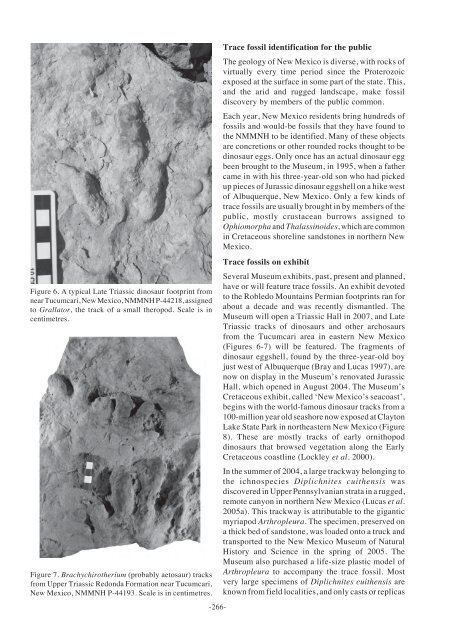eggs, are displayed just above, next to theMississippian core. The core is near a ‘rock video’monitor which uses songs with catchy lyrics to explainthat Ohio is not like it used to be in the prehistoric past(Hannibal 1998a). The songs <strong>and</strong> accompanying videodo not include a discussion of <strong>trace</strong> <strong>fossils</strong>, but theydo provide context for Ohio’s <strong>fossils</strong>.The Museum’s Smead Discovery Center is a largeroom designed for young people to visit in order toexamine <strong>and</strong>, when appropriate, play with materials.It contains one real dinosaur foot impression, a largespecimen that was placed there because it had noaccompanying data <strong>and</strong> was not scientificallyimportant. Several replicas of dinosaur trackways arealso included in this h<strong>and</strong>s-on area. Dinosaurfootprints also appear on a bronze sundial, designedby sculptor Walter Matia in 2004. The sundial,representing the evolution of life over time, is locatedoutside of the Museum.Trace <strong>fossils</strong> <strong>and</strong> urban field tripsTrace <strong>fossils</strong> have been part of field trips <strong>and</strong> classesfor the general public, teachers <strong>and</strong> students at theClevel<strong>and</strong> Museum of Natural History for many years.Trace <strong>fossils</strong> are readily encountered in visits to localstream outcrops. In the urban setting, <strong>trace</strong> <strong>fossils</strong> arealso encountered in slabs of the Lower CarboniferousSalem Limestone, which is also known by thecommercial name of Indiana limestone, as it has longbeen quarried in south-central Indiana. The mostvisually striking of these urban ichno<strong>fossils</strong> is‘Margaritichnus’, an elongate form marked in partwith partitions. This <strong>trace</strong> fossil, noted by otherdesignations, including worm castings (Shrock 1935),has long been known from the Salem Limestone.‘Margaritichnus’ is found in stone used for a numberof buildings in Clevel<strong>and</strong>, including Saint John’sCathedral downtown <strong>and</strong>, closer to the Museum, theVeteran’s Administration Hospital <strong>and</strong> buildings onthe Case Western Reserve University campus(Hannibal <strong>and</strong> Schmidt 1991, figure 2). Theichnofossil is also found in Indiana limestone usedfor structures in many other cities in the UnitedStates.New Mexico Museum of Natural History<strong>and</strong> ScienceTrace fossil collectionAs noted above, the New Mexico Museum of NaturalHistory <strong>and</strong> Science (NMMNH) houses NorthAmerica’s most extensive collection of Permianvertebrate footprints (Figure 5). This collection hasbeen extensively documented (see articles in LucasFigure 5. A characteristic Early Permian vertebratefootprint from New Mexico, NMMNH P-2459, assignedto Ichniotherium, the track of a diadectomorph ‘amphibian’.Scale is in centimetres.<strong>and</strong> Heckert 1995, Lucas et al. 2005). Numerousinvertebrate trackways <strong>and</strong> other <strong>trace</strong>s of Permianage are also part of this collection. Furthermore, theMuseum has a large collection of Triassic vertebratetracks (Figures 6, 7) <strong>and</strong> invertebrate trails from NewMexico, as well as smaller collections of Jurassic,Cretaceous <strong>and</strong> Cenozoic vertebrate <strong>and</strong> invertebrate<strong>trace</strong>s from New Mexico. The emphasis of thecollection is on nonmarine <strong>trace</strong> <strong>fossils</strong> from fluvial<strong>and</strong> lacustrine palaeoenvironments. The <strong>trace</strong>s arehoused on open shelving in an approximately 1,000square-foot area within the Museum’s GeoscienceCollection. However, plans are underway to movethe collection into a newly remodelled, larger space,so that the <strong>trace</strong> fossil collection will have its ownseparate area with much room for expansion. TheMuseum also has large holdings of Permian <strong>and</strong>Triassic vertebrate coprolites (fossil faeces) (Hunt etal. 1998). The coprolites are housed in metal cabinetstogether with other <strong>fossils</strong>, mostly bones <strong>and</strong> teeth,from the same or nearby sites.-265-
Figure 6. A typical Late Triassic dinosaur footprint fromnear Tucumcari, New Mexico, NMMNH P-44218, assignedto Grallator, the track of a small theropod. Scale is incentimetres.Figure 7. Brachychirotherium (probably aetosaur) tracksfrom Upper Triassic Redonda Formation near Tucumcari,New Mexico, NMMNH P-44193. Scale is in centimetres.-266-Trace fossil identification for the publicThe geology of New Mexico is diverse, with rocks ofvirtually every time period since the Proterozoicexposed at the surface in some part of the state. This,<strong>and</strong> the arid <strong>and</strong> rugged l<strong>and</strong>scape, make fossildiscovery by members of the public common.Each year, New Mexico residents bring hundreds of<strong>fossils</strong> <strong>and</strong> would-be <strong>fossils</strong> that they have found tothe NMMNH to be identified. Many of these objectsare concretions or other rounded rocks thought to bedinosaur eggs. Only once has an actual dinosaur eggbeen brought to the Museum, in 1995, when a fathercame in with his three-year-old son who had pickedup pieces of Jurassic dinosaur eggshell on a hike westof Albuquerque, New Mexico. Only a few kinds of<strong>trace</strong> <strong>fossils</strong> are usually brought in by members of thepublic, mostly crustacean burrows assigned toOphiomorpha <strong>and</strong> Thalassinoides, which are commonin Cretaceous shoreline s<strong>and</strong>stones in northern NewMexico.Trace <strong>fossils</strong> on exhibitSeveral Museum <strong>exhibits</strong>, past, present <strong>and</strong> planned,have or will feature <strong>trace</strong> <strong>fossils</strong>. An exhibit devotedto the Robledo Mountains Permian footprints ran forabout a decade <strong>and</strong> was recently dismantled. TheMuseum will open a Triassic Hall in 2007, <strong>and</strong> LateTriassic tracks of dinosaurs <strong>and</strong> other archosaursfrom the Tucumcari area in eastern New Mexico(Figures 6-7) will be featured. The fragments ofdinosaur eggshell, found by the three-year-old boyjust west of Albuquerque (Bray <strong>and</strong> Lucas 1997), arenow on display in the Museum’s renovated JurassicHall, which opened in August 2004. The Museum’sCretaceous exhibit, called ‘New Mexico’s seacoast’,begins with the world-famous dinosaur tracks from a100-million year old seashore now exposed at ClaytonLake State Park in northeastern New Mexico (Figure8). These are mostly tracks of early ornithopoddinosaurs that browsed vegetation along the EarlyCretaceous coastline (Lockley et al. 2000).In the summer of 2004, a large trackway belonging tothe ichnospecies Diplichnites cuithensis wasdiscovered in Upper Pennsylvanian strata in a rugged,remote canyon in northern New Mexico (Lucas et al.2005a). This trackway is attributable to the giganticmyriapod Arthropleura. The specimen, preserved ona thick bed of s<strong>and</strong>stone, was loaded onto a truck <strong>and</strong>transported to the New Mexico Museum of NaturalHistory <strong>and</strong> Science in the spring of 2005. TheMuseum also purchased a life-size plastic model ofArthropleura to accompany the <strong>trace</strong> fossil. Mostvery large specimens of Diplichnites cuithensis areknown from field localities, <strong>and</strong> only casts or replicas
















